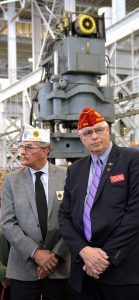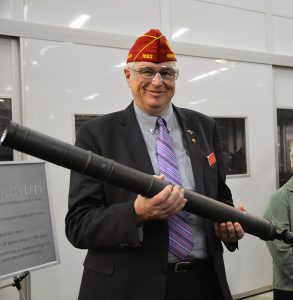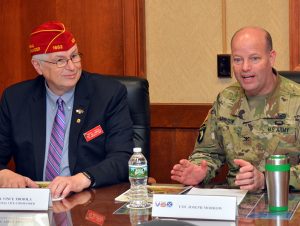Latest News
-
Friday, April 07, 2017
National Vice Commander Troiola Visits Watervliet Arsenal
Legion and Arsenal Have Long History Together
American Legion National Vice Commander V. James Troiola visited the historic Watervliet Arsenal on April 6, accompanied by New York American Legion Department Commander John Sampson and several other Legion leaders. “The one thing that stood out more than any other is just how much pride each worker has in what they are doing for our country,” Troiola said. “Wherever I went today, every employee was not just friendly, they were also very committed to supporting our troops.”

Department of New York Adjutant James Casey and National Vice Commander V. James Troiola during a tour of the Watervliet Arsenal.
The arsenal’s public affairs director, John B. Snyder, took advantage of the occasion to reflect on the long history of Legion and arsenal interaction. Photos are U.S. Army Photos.
By JOHN B. SNYDER
WATERVLIET, N.Y. (April 7, 2017) — The Watervliet Arsenal workforce heard praise from a U.S. Army general who proclaimed that arsenals are the first line of defense for our country and therefore, the maintenance and efficiency of the arsenals should be of the first importance to the preparedness of this nation. Although this statement sounds as if the current Army’s chief of staff may have just made that comment before Congress, he would have been 80 years too late.
In the summer of 1934, then Brig. Gen. William H. Tschappat drafted an article titled, “The Core of Our Preparedness,” which was posted in the American Legion’s August magazine.
If anyone knew ordnance and munitions well enough to write for a national magazine, it certainly was Tschappat. After all, he had graduated from West Point in 1896 and commissioned as an Ordnance officer; served at the Picatinny Arsenal, Watertown Arsenal, Sandy Hook Proving Ground, and the Aberdeen Proving Ground; and became the Army’s Chief of Ordnance from 1934 to 1938.
In that article, Tschappat greatly valued the nation’s arsenals having said that they were very capable of quick expansion in a national emergency, as well as critical to what was then called essential pioneering work. Today, this pioneering work is called prototype development that still goes on at the Watervliet Arsenal.
And several other points that Tschappat made in that historic article remain true today.
After the Great War, the arsenals had fallen into a state of low production and investment, Tschappat said. When wars end, there is little investment in the capability of the arsenals and therefore, capability struggles to keep up with modern technology. Although the general public is little acquainted with the arsenals, the scientific world well recognizes arsenals for their research discoveries, inventions, and their development of industrial processes.
And on a more positive note, Tschappat said the pride of workmanship is a characteristic of the permanent civilian workforce. That old guild spirit existed then as it does today.
But this review of a 1934 article begs the question as to why this is of concern to the Arsenal today?

National Vice Commander V. James Troiola checks out a 60mm mortar tube during his tour of the Watervliet Arsenal.
On April 6, 2017, Vincent J. Troiola, a National Vice Commander for the American Legion visited the historic Arsenal for his first time. He was accompanied by New York American Legion Department Commander John Sampson and several other Legion leaders.
As with any visit by a civic, business, or military leader, the Arsenal staff conducts a quick background review so that its leaders are better prepared for the visit. Such was the case in the preparation for the American Legion.
What the Arsenal had found is that although the Arsenal claims to have a great relationship with the Legion, it wasn’t always so.
In 1932, local American Legion leaders attempted to close the Arsenal. But thanks to the Troy Record newspaper, its timeless commentary regarding the value of the Arsenal to the community and to the nation helped save the Arsenal from closure. In the defense of the American Legion, however, their efforts were noble in that they had envisioned the establishment of a Veterans Hospital on the Arsenal grounds.
Nevertheless, the American Legion redeemed itself, so to speak, by publishing an article in its national magazine two years after the attempted takeover in 1932. Today, the Arsenal and the American Legion participate together in more than 40 community events every year, and are often invited to each other’s functions and facilities.
Although this was Troiola’s first visit to the Arsenal, he quickly picked up on the essence as to why the Arsenal is still operating after 203 years of service to the country.
“The one thing that stood out more than any other is just how much pride each worker has in what they are doing for our country,” Troiola said. “Wherever I went today, every employee was not just friendly, they were also very committed to supporting our troops.”
Before the American Legion left, Arsenal Commander Col. Joseph Morrow once again thanked the Legion for all that they do to support the nation’s troops, Veterans, and their family members. Troiola echoed the thanks not just for the tour and the briefing, but also for providing the nation’s troops with the weapon systems that will keep them safe.
